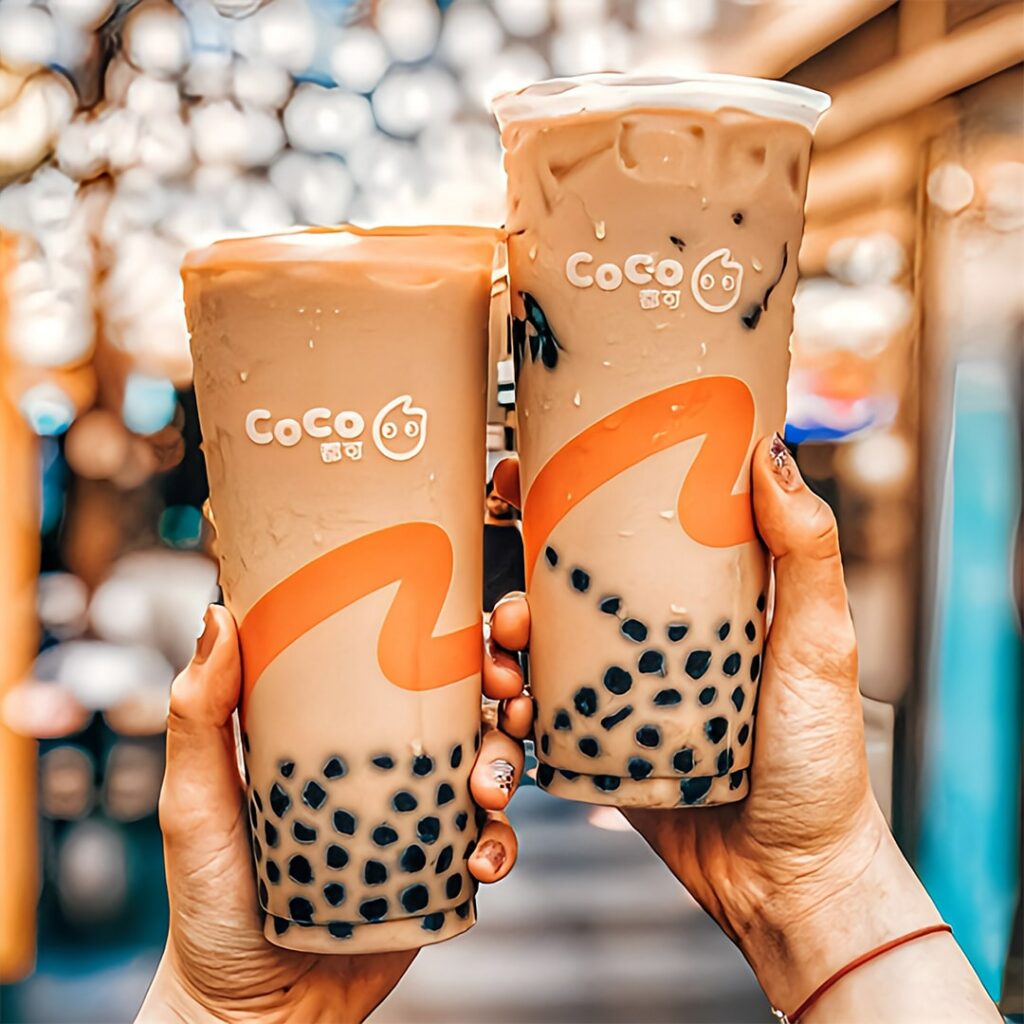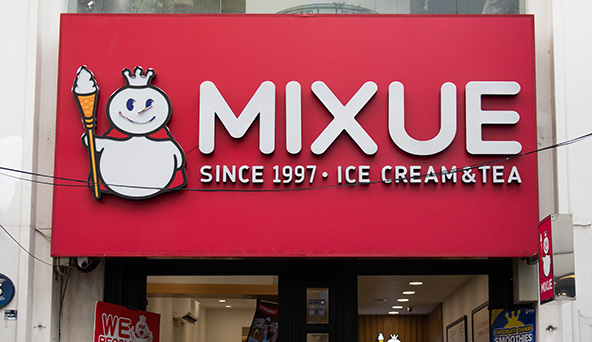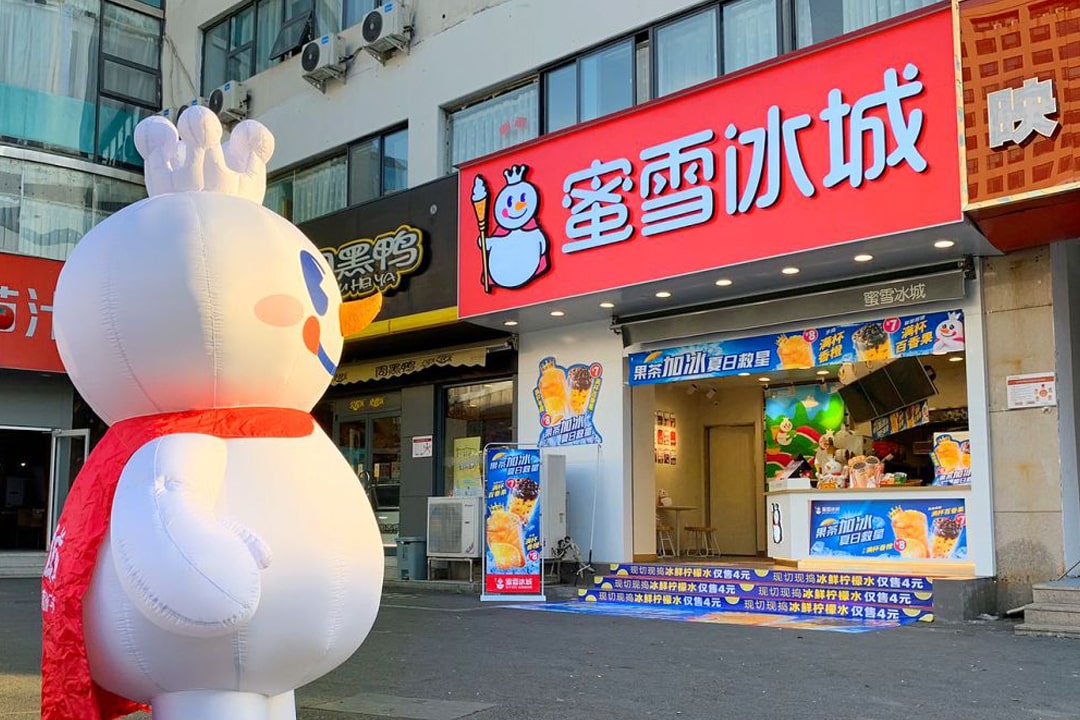Franchise tea chains in bustling Southeast Asia often juggle two tasks: catering to local customers and accommodating successive waves of franchise research teams from China. Since last year, an increasing number of tea brands and suppliers have made exploring the Southeast Asian market a focal point. They shuttle back and forth, actively participating in regional expos and conducting surveys of local stores. Their curiosity is fueled by the belief that this region offers fertile ground for their ventures.
Brands such as Nayuki, Heytea, and Mixue Bingcheng have already left a significant mark in Southeast Asia. According to a report by Momentum Works, the annual consumption of new-style tea beverages in Southeast Asia amounted to USD 3.66 billion. Indonesia led with USD 1.6 billion, nearly half of the total, followed by Thailand at USD 749 million.
In contrast, the Chinese tea market has matured into a battleground among several dominant brands. The international expansion of tea chains is not a new phenomenon; brands like Alittle Tea (stylized as “ALittle Tea”) and Coco (stylized as “CoCo”) explored overseas markets years ago. However, this current wave of global expansion goes beyond brands merely testing the waters. At this juncture, going global has seemingly become a necessary step for their growth.

Why are Chinese tea brands expanding into Southeast Asia?
Walking through the night markets of Ho Chi Minh City in Vietnam or the streets of Bangkok in Thailand, Feng Hu sees shadows of Guangzhou and Shenzhen from a decade ago. He believes the region is full of opportunities but also realizes that Southeast Asia cannot be directly compared to China’s market a decade ago. Feng Hu is the alias of the founder of Uhoo Tea, a solutions provider focused on the tea beverage market. In August 2022, the company established Uhooglobal, a separate entity, to focus on overseas markets.
Last year, Feng Hu spent a considerable amount of time delving into Southeast Asia, personally visiting Malaysia, Thailand, Indonesia, Vietnam, and other countries in the region.
“The nightlife of young people in Ho Chi Minh City is rich, and they have many night markets. You can feel the strong consumption desire of young people when you’re there,” Feng Hu told Tech Planet. “In many places, there are brands selling milk tea for over RMB 20 (USD 2.7) per cup, as well as street vendors selling brewed milk tea for RMB 3–4 (USD 0.4–0.5). These types have already been phased out in China,” Feng Hu said. “China’s tea beverage market has entered the stage of digital and intelligent transformation, while the Southeast Asian market still has the 1.0 model of single-store brands and chain brands in the capital phase.”
Due to the climate, the average temperature in Southeast Asian countries is close to 30 degrees Celsius throughout the year, resulting in a year-round demand for cold beverages. In Southeast Asia, there’s no off-season for tea brands. While domestic brands in China have tried introducing hot drinks to attract young consumers, stores in Southeast Asia still feature summer menus. Even in December, Jiang Xin, a tea franchisee working in the region, sells hundreds of cups of lemonade each day.
Feng Hu also said that, unlike the emphasis on health and wellness in China, people in Southeast Asia generally have a sweet tooth. Milk tea is naturally appealing and locals hardly choose low-sugar options. However, it’s worth noting that there hasn’t been a local tea brand in Southeast Asia with over a thousand stores—most brands have fewer than a hundred stores.
According to Chen Jing, an individual who has been living in Vietnam for many years, there are many self-developed tea brands in Vietnam, but they lack scale and are not well-known. Insiders who have visited Southeast Asia told Tech Planet that some of these local brands resemble the early forms of brands like Alittle Tea and Coco. This has caught the attention of Chinese brands. After all, in China, tea brands are already competing on a massive scale in a saturated market.
According to Tech Planet, Nayuki said that the climate and consumer preferences in Southeast Asia closely resemble the Chinese market, making it an ideal target market for Chinese tea brands looking to expand abroad.
Jiang chose to venture overseas because he did not want to get caught up in the intense competition in China. In 2019, when Mixue Bingcheng expanded into Vietnam, Jiang closely monitored its developments. In 2023, when Mixue commenced franchising in Thailand, he immediately applied. “I opened a catering franchise in China a few years ago. I know it’s too competitive in China, so I pay more attention to the movement of brands overseas,” Jiang said.
Mixue Bingcheng is currently one of the most established brands in the Southeast Asian market, with nearly 4,000 stores. Another brand that ventured overseas around the same time is Chagee. According to official data, Chagee now has nearly 100 international stores, spread across Malaysia, Singapore, and Thailand, with over 50 stores in Malaysia alone.

In the Malaysian market, Heytea is considered one of the top tea brands. In the latter half of 2023, Heytea also landed in Malaysia. Nayuki also re-entered the regional market in December last year, opening its first store in Thailand under the banner of Naixue. A Nayuki representative told Tech Planet that Thailand is currently the country recovering the quickest in the region’s tourism market, having introduced various policies to attract tourists, especially from China.
Mixue, Heytea, and Chagee are just several of many tea brands and suppliers that are on the road to international expansion, viewing Southeast Asia as the next battleground.
Faster returns than in China
Jiang can be considered one of the first franchisees of Mixue Bingcheng in Thailand. When he applied, there were only around a dozen Mixue stores in the country. The cost of establishing a Mixue store abroad is similar to that in China, ranging from RMB 400,000–500,000 (USD 55,800–69,800) in the initial stages, including decoration, franchise fees, initial materials, and rent. The policies are also largely similar to those in China.
However, the process of establishing a store is more complicated than imagined.
“The first thing is to have a local company in Thailand, then obtain a local food and beverage license, and also contribute to social security for employees,” Jiang told Tech Planet. Every step, from site selection and decoration to hiring staff, is more challenging than in China. “Because of the language barrier, I was prepared to encounter difficulties before coming to Thailand,” Jiang said.
Compared to other franchisees who prefer to open stores in tourist areas with a large Chinese population, Jiang prefers targeting locations with more locals. “Chinese people will be curious and take pictures when they see it, but the consumption rate is very low,” Jiang said. His store is situated on a street that has become a popular check-in spot in Bangkok. Lisa, a member of the South Korean idol group Blackpink, once visited this street. There are also two high schools situated in the vicinity.
Since Jiang’s store opened, daily sales have remained stable at RMB 6,000–8,000 (USD 830–1,110). The profit margin can reach 45–52%. This performance has exceeded his expectations, as he did not anticipate the locals to be so receptive to foreign brands. Jiang also said that most franchisees in Thailand can achieve this level of performance, with stores in better locations likely achieving even higher margins. With the same investment cost, franchisees are therefore likely to recoup their investment earlier by setting up shop in Southeast Asia than in China.
In Southeast Asia, Mixue Bingcheng relies on low prices to attract locals. Whether in Vietnam, Indonesia, or Thailand, Mixue’s first impression among locals is that it is affordable. However, Southeast Asians are more likely to see it as an ice cream shop rather than a milk tea brand. In Thailand and Vietnam, sales of ice cream cones and sundaes far exceed those of milk tea. “McDonald’s employees come and ask me why everyone buys Mixue Bingcheng’s [ice cream] cones, even though the prices are the same,” a Mixue franchisee in Thailand said.
“Everyone can afford it—that’s how Mixue Bingcheng is positioned in Vietnam,” said Wang Jianxin, who has lived in Vietnam for seven years. In Thailand, Mixue’s ice cream cones are sold for RMB 3 (USD 0.4), and lemonade is sold for RMB 4 (USD 0.5).
But unlike other brands, Mixue’s stores are not limited to commercial areas. Brands like Heytea, Nayuki, and Mixue typically choose premium locations for overseas stores, adopting a high-end route. For instance, Nayuki’s first store in Thailand is located in EmSphere, a newly opened high-end shopping mall in Thailand.
A Nayuki representative told Tech Planet that, in the early stages of overseas expansion, the brand will continue insisting on creating a third space, instead of solely establishing small street shops. “Whether it’s Southeast Asia, Europe, or America, the pace of life is not as fast, and consumers like spaces where they can sit down and enjoy, so we provide more space to accommodate this preference,” the representative said.
Nayuki’s latest data shows that its stores in Thailand have achieved daily sales exceeding THB 150,000 (USD 4,220), with the highest daily turnover surpassing THB 200,000 (USD 5,630). The prices of Nayuki’s products are at least RMB 10 (USD 1.4) or higher. Heytea has similarly pursued a high-end route in Southeast Asia. In Malaysia, it signed Malaysian former badminton star Lee Chong Wei as its spokesperson, positioning itself as “Starbucks of the East.” In Southeast Asia, Heytea’s price range belongs to the highest tier, ranging from RMB 20–30 (USD 2.8–4.2).
In Thailand, milk tea prices typically fall below RMB 15 (USD 2), but that has not prevented Heytea from becoming a popular brand. A Chinese resident living in Thailand told Tech Planet that, during the pandemic, she did not see any customers in Heytea stores, but there were continuous takeaway orders. The staff were continuously preparing beverages even as she left the store.
High employee turnover, immature supply chain, and frequent shortages
Franchisees opening stores in Southeast Asia may not need to worry about order volumes, but they have the concern of not having enough tea to sell. Feng Hu said that the supply chain is by far the major issue affecting businesses that want to expand into the region. “As local production is not possible, cross-border logistics can become extremely unstable,” he said.
“In fact, the cost of transporting goods to Southeast Asia is not bad, but each country enforces different customs policies,” an industry insider said. This results in the extension of the entire logistics and transportation cycle.
Mixue Bingcheng is the brand most affected by the supply chain despite opening its own logistics warehouse in Bangkok. Jiang purchases lemons locally, but other ingredients and materials like tea leaves, milk tea powder, ice cream powder, plastic cups, and straws, among others, need to be shipped from the headquarters. Jiang said that the supply is currently relatively stable, but there were frequent shortages in the early stages. Some peripheral products still occasionally experience shortages.
This issue is not only present in Thailand but has also occurred in Malaysia and other parts of the region since May last year. On Xiaohongshu (also known internationally as Red), a Malaysian user once posted that the local Mixue stores were severely understocked to the extent that only lemonade was being sold. Logistics issues limit regional expansion. Currently, the brands in Thailand are primarily concentrated in Bangkok where the consumption level is high and logistics run smoothly. In other regions, however, logistical costs will likely be higher.
In spite of the issues to do with the unstable supply chain, most brands continue to import what they need for their stores in Southeast Asia from factories in China. Mixue, for instance, has not sought to establish factories locally despite having over a thousand stores in the region. The immaturity of the regional supply chain and lower production costs in China are often cited as the key reasons.
In addition to worrying about not having tea to sell, franchisees also need to worry that their stores will have no one to prepare the beverages the next day. In Southeast Asia, employee turnover is much higher than in China. With the slower pace of life in Southeast Asia, franchisees, such as Jiang in Thailand, often encounter situations where employees leave immediately after receiving their wages.
Despite these challenges, Jiang considers himself fortunate not to have faced employee resignations in the past six months. To enhance employee job satisfaction, he deliberately allows his employees to show him the ropes, playing the role of a boss who pretends not to understand everything.
Opening four franchise stores in six months
For Feng Hu, the window of opportunity in Southeast Asia will remain open for the next three years, fueled by the industry’s expansiveness and aggressiveness. However, in the eyes of Jiang, it may already be getting too late for those looking to target the region.
Even as his first store was still under renovation, Jiang had already secured three more locations in Bangkok. “If we didn’t secure the locations early, there would be no good spots left. Now, there are hardly any prime spots available,” Jiang told Tech Planet. In just six months, Jiang opened four Mixue Bingcheng stores in Bangkok. Yet, he isn’t the most daring franchisee. According to Jiang, Thai franchisees typically operate as a team, with clearly designated roles in site selection, negotiation, and overseeing renovations. He, on the other hand, is a one-man show.
Within a span of six months, Jiang has hosted several research teams from Chinese tea brands at his stores. This trend reassured him that his decision to establish four stores at once was the right move. Come next year, the streets of Bangkok will witness more Chinese tea brands appearing on the scene.
In terms of experience, resources, and capability, Chinese brands indeed have the ability to dominate, but Feng Hu doesn’t believe that just bringing a brand to Southeast Asia ensures victory. “Each country in Southeast Asia has a unique situation. It’s still necessary to cultivate the market, either through distributors, remote management, or sending a team there. Simply putting a brand out won’t work,” he said.
Mixue Bingcheng faced challenges when it opened its first stores in Thailand. “There was a miscalculation initially, when Mixue placed its stores near schools to target student consumers,” insiders told Tech Planet. “But in Thailand, students have unusually long holidays, and the stores near schools didn’t generate high revenue.” It wasn’t until Mixue shifted its stores to commercial areas that it gained traction in Bangkok. However, as of December 2023, Mixue has temporarily halted franchise operations in Southeast Asia albeit with plans to resume in 2024. The company has yet to respond to Tech Planet’s inquiries.
The Southeast Asian market shares significant commonalities while also having distinct differences. 11 countries, dozens of languages, and diverse economic, cultural, and religious landscapes. In the eyes of Feng Hu, a broad deployment strategy won’t succeed in establishing a genuine local brand.
Southeast Asia may seem like a lucrative market for Jiang and others who have ventured inward. However, the window of opportunity may be fleeting and fast closing.
This article was adapted based on a feature originally written by Xi Rui and published on Tech Planet (WeChat ID: tech618). KrASIA is authorized to translate, adapt, and publish its contents.

